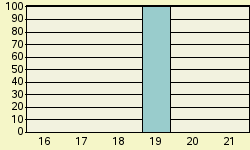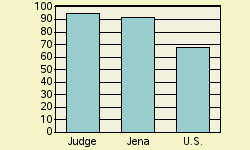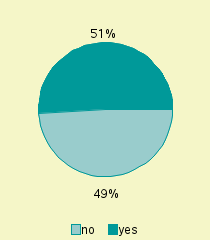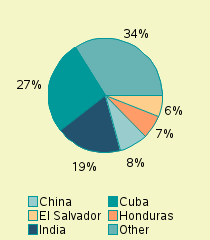Judge Grady A. Crooks
FY 2016 - 2021, Jena Immigration Court
Attorney General Jeff Sessions appointed Grady A. Crooks to begin hearing cases in October2018. Judge Crooks earned a Bachelor of Science in 1996 from North Dakota State University, aMaster of Arts in 1999 from The George Washington University, and a Juris Doctor in 2004from the Rutgers University School of Law. In 2017, he served as an assistant U.S. attorney atthe U.S. Attorney’s Office for the Western District of Louisiana in Shreveport, Louisiana. From2005 to 2016, he was an attorney for the U.S. Air Force in the following locations: Barksdale AirForce Base, Louisiana; Guantánamo Bay, Cuba; Hurlburt Field, Florida; International SecurityAssistance Force in Kabul, Afghanistan; Baghdad, Iraq; Tyndall Air Force Base, Florida; andOffutt Air Force Base, Nebraska. Judge Crooks is a member of the District of Columbia Bar.
Deciding Asylum Cases
Detailed data on Judge Crooks decisions were examined for the period covering fiscal years 2016 through 2021. During this period, Judge Crooks is recorded as deciding 245 asylum claims on their merits. Of these, he granted 12, gave no conditional grants, and denied 233. Converted to percentage terms, Crooks denied 95.1 percent and granted (including conditional grants) 4.9 percent. Figure 1 provides a comparison of Judge Crooks's denial rate fiscal year-by-year over this recent period. (Rates for years with less than 25 decisions are not shown.)
Nationwide Comparisons
Compared to Judge Crooks's denial rate of 95.1 percent, nationally during this same period, immigration court judges denied 67.6 percent of asylum claims. In the Jena Immigration Court where Judge Crooks was based, judges there denied asylum 91.9 percent of the time. See Figure 2.
Judge Crooks can also be ranked compared to each of the 558 individual immigration judges serving during this period who rendered at least one hundred decisions in a city's immigration court. If judges were ranked from 1 to 558 - where 1 represented the highest denial percent and 558 represented the lowest - Judge Crooks here receives a rank of 63. That is 62 judges denied asylum at higher rates, and 495 denied asylum at the same rate or less often. Ranks are tallied separately for each immigration court. Should a judge serve on more than one court during this period, separate ranks would be assigned in any court that the judge rendered at least 100 asylum decisions in.
Why Do Denial Rates Vary Among Judges?
Denial rates reflect in part the differing composition of cases assigned to different immigration judges. For example, being represented in court and the nationality of the asylum seeker appear to often impact decision outcome. Decisions also appear to reflect in part the personal perspective that the judge brings to the bench.
Representation
If an asylum seeker is not represented by an attorney, almost all (88%) of them are denied asylum. In contrast, a significantly higher proportion of represented asylum seekers are successful. In the case of Judge Crooks, 49% were not represented by an attorney. See Figure 3. For the nation as a whole, about 18.3% of asylum seekers are not represented.
Nationality
Asylum seekers are a diverse group. Over one hundred different nationalities had at least one hundred individuals claiming asylum decided during this period. As might be expected, immigration courts located in different parts of the country tend to have proportionately larger shares from some countries than from others. And, given the required legal grounds for a successful asylum claim, asylum seekers from some nations tend to be more successful than others.
For Judge Crooks, the largest group of asylum seekers appearing before him came from Cuba. Individuals from this nation made up 26.5 % of his caseload. Other nationalities in descending order of frequency appearing before Judge Crooks were: India (18.8 %), China (8.2%), Honduras (6.5%), El Salvador (6.1%). See Figure 4.
In the nation as a whole during this same period, major nationalities of asylum seekers, in descending order of frequency, were El Salvador (18.7%), Guatemala (16.0%), Honduras (15.0%), Mexico (11.8%), China (8.4%), India (3.8%), Cuba (2.7%), Haiti (1.8%), Venezuela (1.6%), Cameroon (1.5%), Nicaragua (1.2%), Nepal (1.2%), Ecuador (1.1%).




